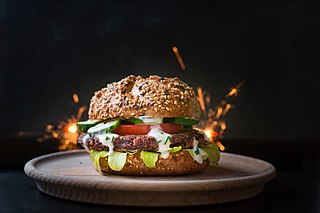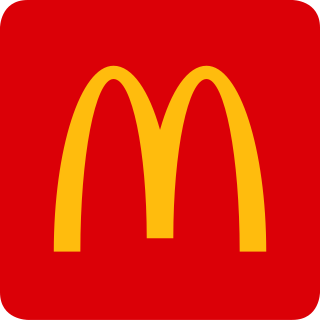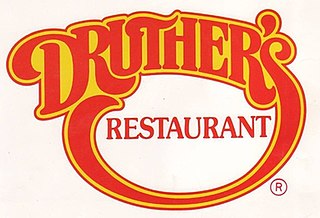
A hamburger, or simply a burger, is a dish consisting of fillings—usually a patty of ground meat, typically beef—placed inside a sliced bun or bread roll. The patties are often served with cheese, lettuce, tomato, onion, pickles, bacon or chilis with condiments such as ketchup, mustard, mayonnaise, relish or a "special sauce", often a variation of Thousand Island dressing and are frequently placed on sesame seed buns. A hamburger patty topped with cheese is called a cheeseburger.

A fast-food restaurant, also known as a quick-service restaurant (QSR) within the industry, is a specific type of restaurant that serves fast-food cuisine and has minimal table service. The food served in fast-food restaurants is typically part of a "meat-sweet diet", offered from a limited menu, cooked in bulk in advance and kept hot, finished and packaged to order, and usually available for take away, though seating may be provided. Fast-food restaurants are typically part of a restaurant chain or franchise operation that provides standardized ingredients and/or partially prepared foods and supplies to each restaurant through controlled supply channels. The term "fast food" was recognized in a dictionary by Merriam–Webster in 1951.

Raymond Albert Kroc was an American businessman. He purchased the fast food company McDonald's in 1961 from the McDonald brothers and was its CEO from 1967 to 1973. Kroc is credited with the global expansion of McDonald's, turning it into the most successful fast food corporation in the world by revenue.

Fast food is a type of mass-produced food designed for commercial resale, with a strong priority placed on speed of service. Fast food is a commercial term, limited to food sold in a restaurant or store with frozen, preheated or precooked ingredients and served in packaging for take-out or takeaway. Fast food was created as a commercial strategy to accommodate large numbers of busy commuters, travelers and wage workers. In 2018, the fast-food industry was worth an estimated $570 billion globally.

Burger Chef was an American fast-food restaurant chain. It began operating in 1954 in Indianapolis, Indiana, expanded throughout the United States, and at its peak in 1973 had 1,050 locations, including some in Canada. The chain featured several signature items, such as the Big Shef and Super Shef hamburgers.

The Red Barn restaurant was a fast-food restaurant chain founded in 1961 in Springfield, Ohio, by Don Six, Martin Levine, and Jim Kirst. In 1963, the small chain was purchased by Richard O. Kearns, operated as Red Barn System, with the offices moving briefly to Dayton, Ohio and in August 1964 to Fort Lauderdale, Florida. During the late 1960s United Servomation, also called Servomation, bought the Red Barn chain. In 1978 United Servomation merged with the City Investing Company's GDV division which also owned the Motel 6 motel chain. Only interested in real estate, construction, and financial services the new owners ceased advertising for the chain along with allowing the franchise leases to expire with the last of the leases expiring around 1988. At its peak, Red Barn had 300–400 restaurants in 19 states, as well as outlets in southern Ontario, elsewhere in Canada, and Australia.

Culver Franchising System, LLC, doing business as Culver's, is an American fast-casual restaurant chain. The company was founded in 1984 by George, Ruth, Craig, and Lea Culver. The first location opened in Sauk City, Wisconsin, on July 18, 1984, under the name "Culver's Frozen Custard and ButterBurgers." The privately held company is headquartered in Prairie du Sac, Wisconsin. The chain operates primarily in the Midwestern United States, and has a total of 965 restaurants in 26 states as of July 2024.

Hot 'n Now is an American fast-food restaurant based in Holt, Michigan. Founded in 1984, the chain once grew to more than 150 locations throughout the United States at its peak. Subsequently, under the ownership of PepsiCo, the chain filed for bankruptcy in 2004, and was then sold to STEN Corporation. As of April 2024, the company operates 1 location in Michigan. The majority of the chain's locations focused entirely on drive-thru service, featuring a small-footprint building with a tall, slanted roof style. Some previous locations were more traditional fast-food locations, complete with seating, and others were combined with gas stations.

McDonald's Corporation is an American multinational fast food chain, founded in 1940 as a restaurant operated by Richard and Maurice McDonald, in San Bernardino, California, United States. They rechristened their business as a hamburger stand, and later turned the company into a franchise, with the Golden Arches logo being introduced in 1953 at a location in Phoenix, Arizona. In 1955, Ray Kroc, a businessman, joined the company as a franchise agent and in 1961 bought out the McDonald brothers. Previously headquartered in Oak Brook, Illinois, it moved to nearby Chicago in June 2018. McDonald's is also a real estate company through its ownership of around 70% of restaurant buildings and 45% of the underlying land.

The American fast-food restaurant chain McDonald's was founded in 1940 and has since grown to the world's largest restaurant chain by revenue.

Druther's is a restaurant, formerly a chain of fast food restaurants that began as Burger Queen restaurants started in Winter Haven, Florida in 1956, and then based in Louisville, Kentucky from 1963 until 1981. The name was a play on the word "druthers", and the mascot was a giant female bee named Queenie Bee. In 1981, Burger Queen changed to Druther's restaurants, although the changes were mostly cosmetic. One reason given for the name change was to eliminate the perception that they specialized in only hamburgers when they also had fried chicken and a serve-yourself salad bar. Druther's featured a character named "Andy Dandytale" on its kids meal items. The chain's slogan was "I'd Ruther Go to Druther's Restaurant." As of April 2024, the company operates 1 location in Kentucky.

Sandy's was a chain of American fast-food restaurants begun in 1956 by four entrepreneurs from Kewanee, Illinois: Gus "Brick" Lundberg, Robert C. Wenger, Paul White and W. K. Davidson. Sandy's was the ancestor of the midwestern franchises of the Hardee's restaurant chain.

Wimpy is a fast-food chain that was founded in the United States. It found its success internationally, mainly in the United Kingdom and South Africa. It has changed between being a table-service establishment and counter-service establishment throughout its history.

McDonald's Israel is the Israeli master franchise of the fast food restaurant chain McDonald's. Currently operated and licensed by Alonyal Limited, McDonald's Israel is the largest of Israel's burger chains with a 60% market share. It was the first Israeli outlet to be opened in 1993 and a major competitor of the local restaurant chain Burger Ranch. The world's first kosher McDonald's was opened in Mevaseret Zion in October 1995. After a sales decline attributed to consumer boycotts as part of the BDS movement, McDonald's Corporation announced in 2024 that it would buy Alyonal pending regulatory approval.

Evidence suggests that the United States was the first country where two slices of bread and a ground beef patty were combined into a "hamburger sandwich" and sold. There is some controversy over the origin of the hamburger because its two basic ingredients, bread and beef, have been prepared and consumed separately for many years in many countries before their combination. Shortly after its creation, the hamburger quickly included all of its currently typically characteristic trimmings, including onions, lettuce, and sliced pickles.

Henry's Hamburgers is a former American fast-food restaurant chain of the 1950s, 1960s, and 1970s. Only one franchise store, in Michigan, remains.
Winky's Hamburgers was a chain of hamburger fast food restaurants in and near Pittsburgh, Pennsylvania. It was founded by two brothers, Harold and Bernard Erenstein in 1962. Their slogans were "Fast Food Cheap" and "Winky's Makes You Happy To be Hungry." Their signs advertised "Winky's Hamburger 15¢"; other sandwiches offered were The Big Wink, The Great One, and The Ground Rounder. Hot dogs also were on the menu. One of the television commercials for the chain featured a puppet monster reading a list of signs featuring the names of the towns where restaurants were located. Upon learning that there was no Winky's in Wilmerding, the monster ate the panel, exclaiming, "There's no Winky's in Wilmerding!"

The oldest McDonald's restaurant is a drive-up hamburger stand at 10207 Lakewood Boulevard at Florence Avenue in Downey, California, United States. It was the third McDonald's restaurant and opened on August 18, 1953. It was also the second restaurant franchised by Richard and Maurice McDonald, before the involvement of Ray Kroc in the company. The restaurant is the oldest one in the chain still in existence and is one of Downey's main tourist attractions. Along with its sign, it was deemed eligible for addition to the National Register of Historic Places in 1984, although it was not added at the time because the owner objected.















